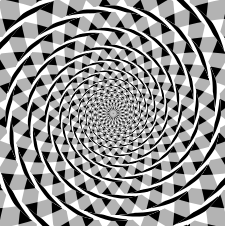Fraser spiral illusion

The Fraser spiral illusion is an optical illusion that was first described by the British psychologist Sir James Fraser (1863 – 1936) in 1908.
The illusion is also known as the false spiral, or by its original name, the twisted cord illusion. The overlapping black arc segments appear to form a spiral; however, the arcs are a series of concentric circles.
The visual distortion is produced by combining a regular line pattern (the circles) with misaligned parts (the differently colored strands).[1] Zöllner's illusion and the café wall illusion are based on a similar principle, like many other visual effects, in which a sequence of tilted elements causes the eye to perceive phantom twists and deviations.
The illusion is augmented by the spiral components in the checkered background.
See also
References
External links
| Wikimedia Commons has media related to Optical illusion. |